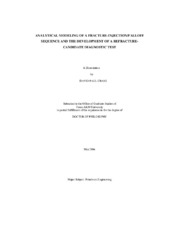| dc.description.abstract | Fracture-injection/falloff sequences are routinely used as pre-frac well tests to estimate reservoir pressure
and transmissibility, but the current interpretation methods are limited to analyzing specific and very small
portions of the pressure falloff data. To remove the current limitations, new analytical fractureinjection/
falloff models are developed that account for fracture propagation, fracture closure, and after
fracture closure diffusion. A fracture-injection/falloff differs from a conventional injection/falloff
sequence in that pressure during the injection is sufficient to initiate and propagate a hydraulic fracture. By
considering fracture propagation as time-dependent storage, three new models are presented for a fractureinjection/
falloff sequence in a well in an infinite slab reservoir with a single vertical fracture created
during the injection and with variable fracture and wellbore storage as follows:
• Equivalent propagating-fracture and before-fracture-closure storage with constant after-fractureclosure
storage.
• Time-dependent propagating-fracture storage, constant before-closure storage, and constant afterclosure
storage.
• Time-dependent propagating-fracture storage, constant before-closure storage with linear flow
from the fracture, and constant wellbore storage and skin with after-closure radial flow.
When a fracture-injection can be considered as occurring instantaneously, limiting-case solutions of the
new fracture-injection/falloff models suggest the observed pressure difference can be integrated to
generate an equivalent pressure difference if the rate were constant. Consequently, a fractureinjection/
falloff sequence can be analyzed with constant-rate, variable-storage type curves.
The new fracture-injection/falloff theory is also extended to allow for a fracture-injection in a reservoir
containing an existing conductive hydraulic fracture. The new multiple-fracture fracture-injection/falloff
model forms the basis of a new refracture-candidate diagnostic test that uses characteristic variable-storage
behavior to qualitatively diagnose a pre-existing fracture retaining residual width and to determine if a preexisting
fracture is damaged. A quantitative analysis methodology is also proposed that uses a new
pressure-transient solution for a well in an infinite-slab reservoir producing through multiple arbitrarilyoriented
finite- or infinite-conductivity fractures. | en |


